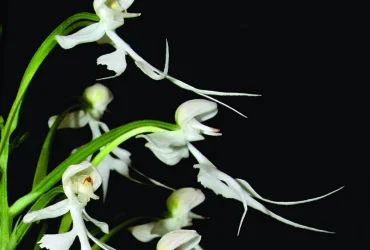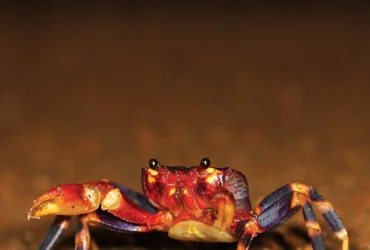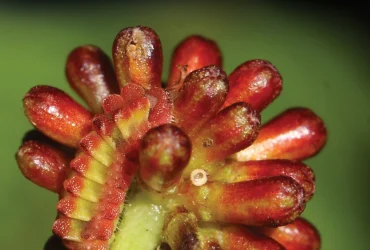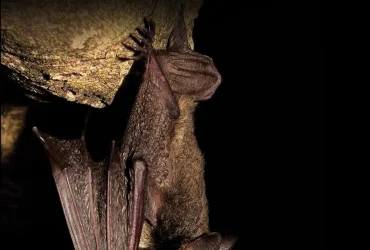Archives
 v7i3.183
v7i3.183ISSN: 1800-427X (print)
eISSN: 1800-427X (online)
Alfred Russel Wallace Centenary Issue
DOI:10.47605/tapro.v7i3.183
Proceedings of the Second International Conference on Alfred Russel Wallace and the Wallacea
Organised by the Indonesian Academy of Sciences
Wakatobi - Indonesia (10–13 November 2013)
J. Supriatna, A.A.T. Amarasinghe, and C. Margules (Editors)
Published date: 30 July 2015
Pp. 120–125.
ALFRED RUSSEL WALLACE AND NATURAL SELECTION: THE REAL STORY
George W. Beccaloni*
*Corresponding author. E-mail: g.beccaloni@nhm.ac.uk
Abstract
Alfred Russel Wallace (1823–1913) was a largely self-educated British naturalist, who co-published the theory of evolution by natural selection with Charles Darwin in 1858, fifteen months before Darwin’s book Origin of species was released. Some have suggested that Wallace’s independent discovery of natural selection in Indonesia in February of that year was merely fortuitous, but in fact it was the culmination of a concerted 10 year personal quest to understand how evolutionary change takes place. Although Wallace was showered with prestigious honours and awards for his great discovery, and in spite of the fact that he became one of the most famous people in the world towards the end of his life, his intellectual legacy was rapidly overshadowed by Charles Darwin’s after his death.
Key words : Charles Lyell, Joseph Hooker, Linnean Society, Malay Archipelago
eISSN: 1800-427X (online)
Alfred Russel Wallace Centenary Issue
DOI:10.47605/tapro.v7i3.183
Proceedings of the Second International Conference on Alfred Russel Wallace and the Wallacea
Organised by the Indonesian Academy of Sciences
Wakatobi - Indonesia (10–13 November 2013)
J. Supriatna, A.A.T. Amarasinghe, and C. Margules (Editors)
Published date: 30 July 2015
Pp. 120–125.
ALFRED RUSSEL WALLACE AND NATURAL SELECTION: THE REAL STORY
George W. Beccaloni*
*Corresponding author. E-mail: g.beccaloni@nhm.ac.uk
Abstract
Alfred Russel Wallace (1823–1913) was a largely self-educated British naturalist, who co-published the theory of evolution by natural selection with Charles Darwin in 1858, fifteen months before Darwin’s book Origin of species was released. Some have suggested that Wallace’s independent discovery of natural selection in Indonesia in February of that year was merely fortuitous, but in fact it was the culmination of a concerted 10 year personal quest to understand how evolutionary change takes place. Although Wallace was showered with prestigious honours and awards for his great discovery, and in spite of the fact that he became one of the most famous people in the world towards the end of his life, his intellectual legacy was rapidly overshadowed by Charles Darwin’s after his death.
Key words : Charles Lyell, Joseph Hooker, Linnean Society, Malay Archipelago
 v7i2.166
v7i2.166ISSN: 1800-427X (print)
eISSN: 1800-427X (online)
DOI:10.47605/tapro.v7i2.166
Submitted date: 9 July 2014
Accepted date: 17 July 2014
Published date: 20 February 2015
Pp. 68–71, Pls. 1–2.
DISCOVERY OF THE CRITICALLY ENDANGERED BULBOUS HERB Crinum woodrowii (AMARYLLIDACEAE) & ITS NEOTYPIFICATION
R. Kr. Singh* & Arti Garg
*Corresponding author. E-mail: rksbsiadsingh@yahoo.co.in
Abstract
A single population of a critically endangered species, Crinum woodrowii, was discovered from Katraj Ghat, Pune District, Maharashtra, at a location other than its type location. A neotype of the species is designated here and its detailed description, distribution, habitat, IUCN threat status, and nomenclatural notes are provided.
Key words : habitat, Katraj Ghat, Maharashtra, neotype, new locality, taxonomy
Section Editor: James L. Reveal
eISSN: 1800-427X (online)
DOI:10.47605/tapro.v7i2.166
Submitted date: 9 July 2014
Accepted date: 17 July 2014
Published date: 20 February 2015
Pp. 68–71, Pls. 1–2.
DISCOVERY OF THE CRITICALLY ENDANGERED BULBOUS HERB Crinum woodrowii (AMARYLLIDACEAE) & ITS NEOTYPIFICATION
R. Kr. Singh* & Arti Garg
*Corresponding author. E-mail: rksbsiadsingh@yahoo.co.in
Abstract
A single population of a critically endangered species, Crinum woodrowii, was discovered from Katraj Ghat, Pune District, Maharashtra, at a location other than its type location. A neotype of the species is designated here and its detailed description, distribution, habitat, IUCN threat status, and nomenclatural notes are provided.
Key words : habitat, Katraj Ghat, Maharashtra, neotype, new locality, taxonomy
Section Editor: James L. Reveal
 v7i1.148
v7i1.148ISSN: 1800-427X (print)
eISSN: 1800-427X (online)
DOI:10.47605/tapro.v7i1.148
Submitted date: 1 October 2014
Accepted date: 20 November 2014
Published date: 19 January 2015
Pp. 1–7, Pl. 1–3.
A NEW MONTANE SPECIES OF THE GENUS Pareas WAGLER, 1830 (SQUAMATA: PAREATIDAE) FROM NORTHERN MYANMAR
Gernot Vogel*
*Corresponding author. E-mail: gernot.vogel@t-online.de
Abstract
A new species of the genus Pareas is described from northern Myanmar. It differs from all other known species of the genus by coloration, which is mainly uniform, and its size (one of the largest species in the genus). Furthermore it is characterized by a low number of supralabials (six), a loreal that touches the orbit, presence of a presubocular and absence of a preocular. The new species was found at an elevation of 1890 m a.s.l. and is regarded as an inhabitant of high elevation mountainous areas.
Key words : Asia, Colubroidea, Oriental region, Pareas vindumi sp. nov., taxonomy
Section Editor: Olivier S.G. Pauwels
eISSN: 1800-427X (online)
DOI:10.47605/tapro.v7i1.148
Submitted date: 1 October 2014
Accepted date: 20 November 2014
Published date: 19 January 2015
Pp. 1–7, Pl. 1–3.
A NEW MONTANE SPECIES OF THE GENUS Pareas WAGLER, 1830 (SQUAMATA: PAREATIDAE) FROM NORTHERN MYANMAR
Gernot Vogel*
*Corresponding author. E-mail: gernot.vogel@t-online.de
Abstract
A new species of the genus Pareas is described from northern Myanmar. It differs from all other known species of the genus by coloration, which is mainly uniform, and its size (one of the largest species in the genus). Furthermore it is characterized by a low number of supralabials (six), a loreal that touches the orbit, presence of a presubocular and absence of a preocular. The new species was found at an elevation of 1890 m a.s.l. and is regarded as an inhabitant of high elevation mountainous areas.
Key words : Asia, Colubroidea, Oriental region, Pareas vindumi sp. nov., taxonomy
Section Editor: Olivier S.G. Pauwels
 v6i2.137
v6i2.137ISSN: 1800-427X (print)
eISSN: 1800-427X (online)
DOI:10.47605/tapro.v6i2.137
Submitted date: 9 July 2013
Accepted date: 17 July 2014
Published date: 30 August 2014
Pp. 72–75, Pls. 1–2.
A NEW SPECIES OF Sonerila (MELASTOMATACEAE) FROM THE WESTERN GHATS OF KERALA, INDIA
K.P. Deepthikumary & A. G. Pandurangan
*Corresponding author. E-mail:
Abstract
A new species, Sonerila keralensis, from the Western Ghats of Kerala is described and illustrated. It is allied to S. rheedei differing by having a tuberous root stock, three to seven flowers, and petals with sparsely glandular-hairy margins.
Key words : taxonomy, Sonerila keralensis, Thirunelli, Melastomataceae, tropical Asia, endemic
Section Editor: James L. Reveal
eISSN: 1800-427X (online)
DOI:10.47605/tapro.v6i2.137
Submitted date: 9 July 2013
Accepted date: 17 July 2014
Published date: 30 August 2014
Pp. 72–75, Pls. 1–2.
A NEW SPECIES OF Sonerila (MELASTOMATACEAE) FROM THE WESTERN GHATS OF KERALA, INDIA
K.P. Deepthikumary & A. G. Pandurangan
*Corresponding author. E-mail:
Abstract
A new species, Sonerila keralensis, from the Western Ghats of Kerala is described and illustrated. It is allied to S. rheedei differing by having a tuberous root stock, three to seven flowers, and petals with sparsely glandular-hairy margins.
Key words : taxonomy, Sonerila keralensis, Thirunelli, Melastomataceae, tropical Asia, endemic
Section Editor: James L. Reveal
 v6i1.120
v6i1.120ISSN: 1800-427X (print)
eISSN: 1800-427X (online)
DOI:10.47605/tapro.v6i1.120
Submitted date: 10 September 2012
Accepted date: 25 February 2013
Published date: 29 June 2014
Pp. 1–6, Pl. 1.
POPULATION DENSITY AND BIOMASS OF THE WILD PREY SPECIES IN A TROPICAL DECIDUOUS FOREST, CENTRAL INDIA
Kannadasan Narasimmarajan*, Subhasis Mahato & Abinash Parida
*Corresponding author. E-mail: wildlife9protect@gmail.com
Abstract
For proper management of a wildlife reserve, it is essential to estimate density and biomass of herbivores that in turn determine the density of carnivores. We estimated the population density and biomass of three ungulates and two other species in the Melghat Tiger Reserve, Central India. The study was conducted from September 2010 to April 2011. We used distance sampling to estimate the population density of wild prey species. The 225km2 intensive study area was found to have high prey species density (69.5±8.3 individuals/km2), with gray langur being the abundant prey species (42.9±7.2 individuals/km2), followed by sambar (10.5±3.5 individuals/km2), gaur (5.8±1.7 individuals/km2), barking deer (2.7±0.3 individuals/km2), and peafowl (7.6±0.6 individuals/km2). When the density figures were multiplied by the average weight of each prey species, biomass of 6501.8 kg/km2 was obtained.
Key words : Abundance; Anthropogenic; Carnivore; Gugamal National Park; Melghat Tiger Reserve
Section Editor: Lee E. Harding
eISSN: 1800-427X (online)
DOI:10.47605/tapro.v6i1.120
Submitted date: 10 September 2012
Accepted date: 25 February 2013
Published date: 29 June 2014
Pp. 1–6, Pl. 1.
POPULATION DENSITY AND BIOMASS OF THE WILD PREY SPECIES IN A TROPICAL DECIDUOUS FOREST, CENTRAL INDIA
Kannadasan Narasimmarajan*, Subhasis Mahato & Abinash Parida
*Corresponding author. E-mail: wildlife9protect@gmail.com
Abstract
For proper management of a wildlife reserve, it is essential to estimate density and biomass of herbivores that in turn determine the density of carnivores. We estimated the population density and biomass of three ungulates and two other species in the Melghat Tiger Reserve, Central India. The study was conducted from September 2010 to April 2011. We used distance sampling to estimate the population density of wild prey species. The 225km2 intensive study area was found to have high prey species density (69.5±8.3 individuals/km2), with gray langur being the abundant prey species (42.9±7.2 individuals/km2), followed by sambar (10.5±3.5 individuals/km2), gaur (5.8±1.7 individuals/km2), barking deer (2.7±0.3 individuals/km2), and peafowl (7.6±0.6 individuals/km2). When the density figures were multiplied by the average weight of each prey species, biomass of 6501.8 kg/km2 was obtained.
Key words : Abundance; Anthropogenic; Carnivore; Gugamal National Park; Melghat Tiger Reserve
Section Editor: Lee E. Harding
Hubungi Kami
The ultimate aim of the journal is to provide an effective medium for communication of the latest and best scientific information.
Copyright © 2020 Taprobanica. All Rights Reserved
Jasa Pembuatan Website by IKT




